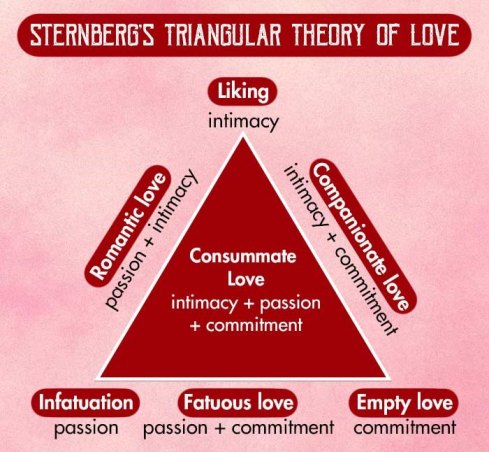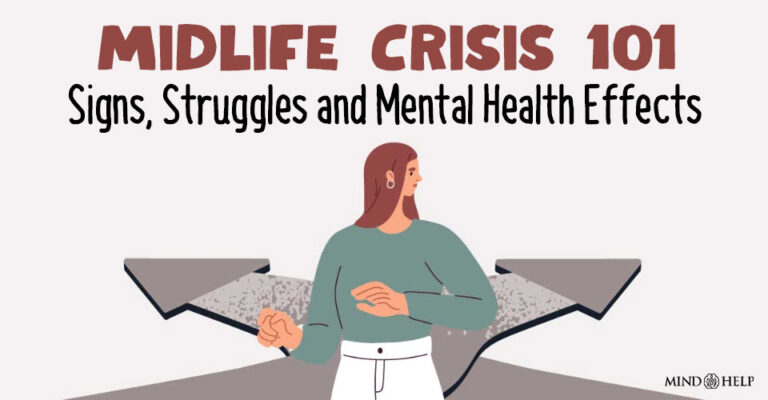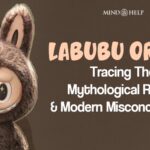Love has been defined and studied by scholars in a variety of approaches. The triangular theory of love was devised by psychologist Robert J. Sternberg and consists of three major components of love – intimacy, passion, and commitment.
Sternberg’s Triangular Theory of Love
According to psychologist Robert Sternberg’s 1 Tobore T. O. (2020). Towards a Comprehensive Theory of Love: The Quadruple Theory. Frontiers in psychology, 11, 862. https://doi.org/10.3389/fpsyg.2020.00862 triangular theory of love, all relationships can be characterized by three main components of love. The triangle is used as a metaphor to describe how the types of love are interrelated.
The three components of love have been discussed below:
1. Intimacy
Intimacy refers to the reciprocal emotional bond, mutual trust, and self-disclosure between two people in a relationship. Intimacy 2 Timmerman G. M. (1991). A concept analysis of intimacy. Issues in mental health nursing, 12(1), 19–30. https://doi.org/10.3109/01612849109058207 occurs when partners share their feelings with one another and enjoy other activities with each other. For intimacy to be present, physical closeness is not necessary.
Read More About Self-Disclosure Here
2. Passion
Passion is governed by the feelings of intensely romantic and physical attraction. This is the component that motivates us to pursue our partners, ask them out, send gifts, and express our love in grand ways. Passion 3 Baumeister R. F. (1999). Passion, intimacy, and time: passionate love as a function of change in intimacy. Personality and social psychology review : an official journal of the Society for Personality and Social Psychology, Inc, 3(1), 49–67. https://doi.org/10.1207/s15327957pspr0301_3 is the component that excites or gets us thinking about being with our partner. It is theorized that passion is at its highest point at the beginning of a relationship.
3. Commitment
This is the intentional and conscious part of a relationship. In the short term, commitment 4 Stanley, S. M., Rhoades, G. K., & Whitton, S. W. (2010). Commitment: Functions, Formation, and the Securing of Romantic Attachment. Journal of family theory & review, 2(4), 243–257. https://doi.org/10.1111/j.1756-2589.2010.00060.x is the decision to love another person while in the long term, it is the decision to maintain that love for the other person. This component is governed by choices and decisions to continue being with a particular person despite everything.
A 1999 study 5 Lemieux, R., & Hale, J. L. (1999). Intimacy, passion, and commitment in young romantic relationships: successfully measuring the triangular theory of love. Psychological reports, 85(2), 497–503. https://doi.org/10.2466/pr0.1999.85.2.497 conducted to test gender differences based on the triangular theory of love found that women scored significantly higher on ‘intimacy’ and ‘commitment’ than men.

The Types of Love
Robert Sternberg pointed out that the three components of love tend to interact, giving rise to different types of relationships.
The value and importance of each component greatly depend on the individuals and the duration of time spent in a relationship. The three components in the triangular theory of love can give rise to eight possible 6 Anderson, J. W. (2016). Sternberg’s Triangular Theory of Love. Encyclopedia of Family Studies, 1–3. https://doi.org/10.1002/9781119085621.wbefs058 love situations. They are as follows:
| Serial Number | Types | Intimacy | Passion | Commitment |
| 1 | Non-Love | |||
| 2 | Liking | Present | ||
| 3 | Infatuation | Present | ||
| 4 | Empty Love | Present | ||
| 5 | Romantic Love | Present | Present | |
| 6 | Companionate Love | Present | Present | |
| 7 | Fatuous Love | Present | Present | |
| 8 | Consummate Love | Present | Present | Present |
1. Non-Love
As the term suggests, this is an absence of any kind of love. In this type, intimacy, passion, and commitment are all absent. No relationship is formed in such a case.
2. Liking
In this form, only the component of intimacy is present while passion and commitment are absent. This is most often seen in casual platonic friendships.
3. Infatuation
Infatuation includes only the component of passion with the absence of the other components. Infatuation involves experiencing feelings of physical passion and lust in the absence of intimacy or commitment. The infatuation phase is often intense and powerful.
4. Empty Love
This form involves commitment without intimacy or passion. Sometimes, a relationship that may have started with deeply passionate love can deteriorate into empty love. It usually occurs in long-term relationships wherein two people are committed to each other as a responsibility but don’t connect with their partner.
Read More About Relationships Here
5. Romantic Love
In this form, the passion and intimacy components are present without commitment. People usually bond through intimacy and physical connection. In such relationships, the couple has deep emotional conversations and likes being in the presence of each other. However, the future of the relationship remains undecided.
6. Companionate Love
Companionate love is derived from the components of intimacy and commitment. This form of love is stronger than friendship but lacks intensity and passion. It can often be found in marriages where the passion has faded but the couple continues to share a strong bond. It is also found between family and friends.
7. Fatuous Love
This form derives from the combination of passion and commitment. The intimacy component is absent in this relationship. It usually comprises a brief duration of passion that is followed by commitment without any emotional intimacy.
8. Consummate Love
This form contains all three components namely, intimacy, passion, and commitment. This form represents the ideal relationship that is intimate, passionate and involves a desire to commit to each other. Couples who are in consummate relationships usually last longer. They are truly happy in each other’s company and share a deep connection.
Importance of the Triangular Theory of Love
The triangular theory is a widely accepted theoretical concept. A 2002 study 7 Lemieux, R., & Hale, J. L. (2002). Cross-sectional analysis of intimacy, passion, and commitment: testing the assumptions of the triangular theory of love. Psychological reports, 90(3 Pt 1), 1009–1014. https://doi.org/10.2466/pr0.2002.90.3.1009 found significant negative correlations between intimacy and relationship length as well as passion and relationship length.
Intimacy and passion scores were lowest for couples who were casually dating and higher for engaged couples. Another 2021 study 8 Sorokowski, P., Sorokowska, A., Karwowski, M., Groyecka, A., Aavik, T., Akello, G., Alm, C., Amjad, N., Anjum, A., Asao, K., Atama, C. S., Atamtürk Duyar, D., Ayebare, R., Batres, C., Bendixen, M., Bensafia, A., Bizumic, B., Boussena, M., Buss, D. M., Butovskaya, M., … Sternberg, R. J. (2021). Universality of the Triangular Theory of Love: Adaptation and Psychometric Properties of the Triangular Love Scale in 25 Countries. Journal of sex research, 58(1), 106–115. https://doi.org/10.1080/00224499.2020.1787318 also confirmed that the components of love tend to differ depending on relationship duration.
How to Apply the Triangular Theory of Love?
Sternberg’s triangular theory of love can help identify which components of love might be lacking in couples so they can work on those areas together. For instance,
- If you have been committed to a relationship for a long time but feel that you are not connected to your partner, the intimacy and passion might have faded.
- Meanwhile, your relationship might be full of passion, however, it can leave you feeling frustrated if there is a lack of commitment.
- On the other hand, you might experience wonderful intimacy with your partner who is faithful to you as you are to them, but a lack of passion might make you feel as though something is missing in the relationship.
Speaking to a marriage/ couples counselor can be helpful for partners to regain the missing components and strive toward consummate love.
Takeaway
Every relationship is different and unique in its way. As per the triangular theory of love, a relationship depends on how each component interacts with the other.
Even though all three components are required to form the ideal relationship, the intensity of each component will determine the quality of the relationship. According to Sternberg, consummate love may be harder to maintain than it is to achieve.
At a Glance
- The triangular theory of love was developed by Robert Sternberg.
- There are three components of love according to this theory – intimacy, passion, and commitment.
- The three components give rise to 8 different types of love – non-love, liking, infatuation, empty love, romantic love, companionate love, fatuous love, and consummate love.
- The triangular theory of love can help determine relationship issues and work on them.
- Research has attested to the validity and importance of this theory.















